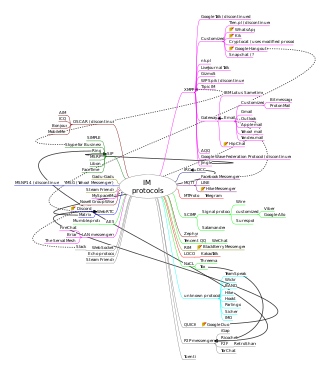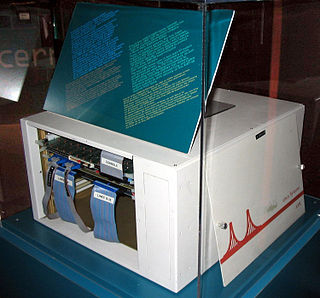An exploit is a piece of software, a chunk of data, or a sequence of commands that takes advantage of a bug or vulnerability to cause unintended or unanticipated behavior to occur on computer software, hardware, or something electronic. Such behavior frequently includes things like gaining control of a computer system, allowing privilege escalation, or a denial-of-service attack.
An intranet is a private network accessible only to an organization's staff. Often, a wide range of information and services are available on an organization's internal intranet that are unavailable to the public, unlike the Internet. A company-wide intranet can constitute an important focal point of internal communication and collaboration, and provide a single starting point to access internal and external resources. In its simplest form, an intranet is established with the technologies for local area networks (LANs) and wide area networks (WANs). Many modern intranets have search engines, user profiles, blogs, mobile apps with notifications, and events planning within their infrastructure.

Instant messaging (IM) technology is a type of online chat that offers real-time text transmission over the Internet. A LAN messenger operates in a similar way over a local area network. Short messages are typically transmitted between two parties, when each user chooses to complete a thought and select "send". Some IM applications can use push technology to provide real-time text, which transmits messages character by character, as they are composed. More advanced instant messaging can add file transfer, clickable hyperlinks, Voice over IP, or video chat.
Voice over Internet Protocol (VoIP), also called IP telephony, is a methodology and group of technologies for the delivery of voice communications and multimedia sessions over Internet Protocol (IP) networks, such as the Internet. The terms Internet telephony, broadband telephony, and broadband phone service specifically refer to the provisioning of communications services over the public Internet, rather than via the public switched telephone network (PSTN).
Whitelisting is the practice of explicitly allowing some identified entities access to a particular privilege, service, mobility, access or recognition. It is the reverse of blacklisting.

A very small aperture terminal (VSAT) is a two-way satellite ground station with a dish antenna that is smaller than 3.8 meters. The majority of VSAT antennas range from 75 cm to 1.2 m. Data rates, in most cases, range from 4 kbit/s up to 16 Mbit/s. VSATs access satellites in geosynchronous orbit or geostationary orbit to relay data from small remote Earth stations (terminals) to other terminals or master Earth station "hubs".
An application service provider (ASP) is a business providing computer-based services to customers over a network; such as access to a particular software application using a standard protocol.
The public switched telephone network (PSTN) is the aggregate of the world's circuit-switched telephone networks that are operated by national, regional, or local telephony operators, providing infrastructure and services for public telecommunication. The PSTN consists of telephone lines, fiber optic cables, microwave transmission links, cellular networks, communications satellites, and undersea telephone cables, all interconnected by switching centers, thus allowing most telephones to communicate with each other. Originally a network of fixed-line analog telephone systems, the PSTN is now almost entirely digital in its core network and includes mobile and other networks, as well as fixed telephones.

Privilege escalation is the act of exploiting a bug, design flaw or configuration oversight in an operating system or software application to gain elevated access to resources that are normally protected from an application or user. The result is that an application with more privileges than intended by the application developer or system administrator can perform unauthorized actions.
udev is a device manager for the Linux kernel. As the successor of devfsd and hotplug, udev primarily manages device nodes in the /dev directory. At the same time, udev also handles all user space events raised when hardware devices are added into the system or removed from it, including firmware loading as required by certain devices.
A dedicated hosting service, dedicated server, or managed hosting service is a type of Internet hosting in which the client leases an entire server not shared with anyone else. This is more flexible than shared hosting, as organizations have full control over the server(s), including choice of operating system, hardware, etc. There is also another level of dedicated or managed hosting commonly referred to as complex managed hosting. Complex Managed Hosting applies to both physical dedicated servers, Hybrid server and virtual servers, with many companies choosing a hybrid hosting solution. There are many similarities between standard and complex managed hosting but the key difference is the level of administrative and engineering support that the customer pays for – owing to both the increased size and complexity of the infrastructure deployment. The provider steps in to take over most of the management, including security, memory, storage and IT support. The service is primarily proactive in nature. Server administration can usually be provided by the hosting company as an add-on service. In some cases a dedicated server can offer less overhead and a larger return on investment. Dedicated servers are hosted in data centers, often providing redundant power sources and HVAC systems. In contrast to colocation, the server hardware is owned by the provider and in some cases they will provide support for operating systems or applications.

Lamit Company is an independent satellite operator company in Europe, operating worldwide. The company provides satellite internet and telephony to primary schools and high schools, universities, government institutions etc.
Areas of the world covered by the company are: Africa (whole), Europe (whole), Middle East (whole), Russia, Australia, Americas, India, Indonesia, etc.

Wireless security is the prevention of unauthorized access or damage to computers or data using wireless networks. The most common types of wireless security are Wired Equivalent Privacy (WEP) and Wi-Fi Protected Access (WPA). WEP is a notoriously weak security standard: the password it uses can often be cracked in a few minutes with a basic laptop computer and widely available software tools. WEP is an old IEEE 802.11 standard from 1997, which was superseded in 2003 by WPA, or Wi-Fi Protected Access. WPA was a quick alternative to improve security over WEP. The current standard is WPA2; some hardware cannot support WPA2 without firmware upgrade or replacement. WPA2 uses an encryption device that encrypts the network with a 256-bit key; the longer key length improves security over WEP. Enterprises often enforce security using a certificate-based system to authenticate the connecting device, following the standard 802.1X.
Mobile VoIP or simply mVoIP is an extension of mobility to a Voice over IP network. Two types of communication are generally supported: cordless/DECT/PCS protocols for short range or campus communications where all base stations are linked into the same LAN, and wider area communications using 3G/4G protocols.
Network Access Control (NAC) is an approach to computer security that attempts to unify endpoint security technology, user or system authentication and network security enforcement.
Split tunneling is a computer networking concept which allows a mobile user to access dissimilar security domains like a public network and a local LAN or WAN at the same time, using the same or different network connections. This connection state is usually facilitated through the simultaneous use of a Local Area Network (LAN) Network Interface Card (NIC), radio NIC, Wireless Local Area Network (WLAN) NIC, and VPN client software application without the benefit of access control.

Cloud computing is the on demand availability of computer system resources, especially data storage and computing power, without direct active management by the user. The term is generally used to describe data centers available to many users over the Internet. Large clouds, predominant today, often have functions distributed over multiple locations from central servers. If the connection to the user is relatively close, it may be designated an edge server.
SIP trunking enables the end point’s PBX to send and receive calls via Internet. As SIP is applied for the signalling protocol for multiple real-time application, SIP trunk is able to control voice, video and messaging applications.
It is also a voice over Internet Protocol (VoIP) technology and streaming media service based on the Session Initiation Protocol (SIP) by which Internet telephony service providers (ITSPs) deliver telephone services and unified communications to customers equipped with SIP-based private branch exchange (IP-PBX) and unified communications facilities. Most unified communications applications provide voice, video, and other streaming media applications such as desktop sharing, web conferencing, and shared whiteboard.
IMS is a set of specifications to offer multimedia services through IP protocol. This makes it possible to incorporate all kinds of services, such as voice, multimedia and data, on an accessible platform through any Internet connection.







